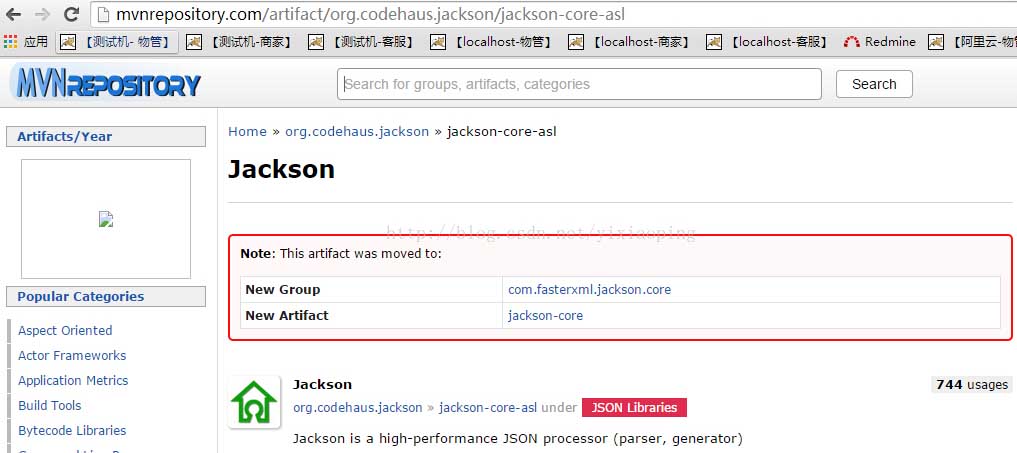闲话少说,刚开始用SpringMVC, 页面要使用jquery的ajax请求Controller。 但总是失败,
主要表现为以下两个异常为:
异常一:java.lang.ClassNotFoundException: org.springframework.http.converter.json.MappingJacksonHttpMessageConverter
异常二:SpringMVC @ResponseBody 415错误处理
网上分析原因很多,但找了很久都没解决,基本是以下几类:
- springmvc添加配置、注解;
- pom.xml添加jackson包引用;
- Ajax请求时没有设置Content-Type为application/json
- 发送的请求内容不要转成JSON对象,直接发送JSON字符串即可
这些其实都没错!!!
以下是我分析的解决步骤方法
1、springMVC配置文件开启注解
|
1
2
|
<!-- 开启注解--> <mvc:annotation-driven /> |
2、添加springMVC需要添加如下配置
(这个要注意spring版本,3.x和4.x配置不同)
spring3.x是org.springframework.http.converter.json.MappingJacksonHttpMessageConverter
spring4.x是org.springframework.http.converter.json.MappingJackson2HttpMessageConverter
具体可以查看spring-web的jar确认,哪个存在用哪个!
spring3.x配置:
|
1
2
3
4
5
6
7
8
9
10
11
12
13
14
15
|
<bean class="org.springframework.web.servlet.mvc.annotation.AnnotationMethodHandlerAdapter"> <property name="messageConverters"> <list> <ref bean="jsonHttpMessageConverter" /> </list> </property></bean><bean id="jsonHttpMessageConverter" class="org.springframework.http.converter.json.MappingJacksonHttpMessageConverter"> <property name="supportedMediaTypes"> <list> <value>application/json;charset=UTF-8</value> </list> </property></bean> |
spring4.x配置:
|
1
2
3
4
5
6
7
8
9
10
11
12
13
14
15
|
<bean class="org.springframework.web.servlet.mvc.annotation.AnnotationMethodHandlerAdapter"> <property name="messageConverters"> <list> <ref bean="jsonHttpMessageConverter" /> </list> </property></bean><bean id="jsonHttpMessageConverter" class="org.springframework.http.converter.json.MappingJackson2HttpMessageConverter"> <property name="supportedMediaTypes"> <list> <value>application/json;charset=UTF-8</value> </list> </property></bean> |
3、pom.xml添加jackson依赖
(这个要注意spring版本,3.x和4.x配置不同)
如果是spring 3.x,pom.xml添加如下配置
|
1
2
3
4
5
6
7
8
9
10
11
12
|
<dependency> <groupId>org.codehaus.jackson</groupId> <artifactId>jackson-core-lgpl</artifactId> <version>1.8.1</version> </dependency> <dependency> <groupId>org.codehaus.jackson</groupId> <artifactId>jackson-mapper-lgpl</artifactId> <version>1.8.1</version> </dependency></span> |
spring4.x, pom.xml添加如下配置
|
1
2
3
4
5
6
7
8
9
10
11
|
<dependency> <groupId>com.fasterxml.jackson.core</groupId> <artifactId>jackson-core</artifactId> <version>2.5.2</version></dependency><dependency> <groupId>com.fasterxml.jackson.core</groupId> <artifactId>jackson-databind</artifactId> <version>2.5.2</version></dependency> |
这里要说明一下,spring3.x用的是org.codehaus.jackson的1.x版本,在maven资源库,已经不在维护,统一迁移到com.fasterxml.jackson,版本对应为2.x

4、ajax请求要求
- dataType 为 json
- contentType 为 'application/json;charse=UTF-8'
- data 转JSON字符串
我的代码:如下: (注意:这里只是针对POST +JSON字符串形式请求,后面我会详细讲解不同形式请求,的处理方法和案例)
|
1
2
3
4
5
6
7
8
9
10
11
12
13
14
15
|
var data = { userAccount: lock_username, userPasswd:hex_md5(lock_password).toUpperCase()}$.ajax({ url : ctx + "/unlock.do", type : "POST", data : JSON.stringify(data), dataType: 'json', contentType:'application/json;charset=UTF-8', success : function(result) { console.log(result); }}); |
5、Controller 接收响应JSON
以上配置OK,Controller中使用JSON方式有多种。这里简单介绍几种。
这个关键在于ajax请求是将数据以什么形式传递到后台,这里我总结了三种形式
- POST + JSON字符串形式
- POST + JSON对象形式
- GET + 参数字符串
方式一: POST + JSON字符串形式,如下:
|
1
2
3
4
5
6
7
8
9
10
11
12
13
14
15
16
|
//请求数据,登录账号 +密码 var data = { userAccount: lock_username, userPasswd:hex_md5(lock_password).toUpperCase() } $.ajax({ url : ctx + "/unlock.do", type : "POST", data : JSON.stringify(data), //转JSON字符串 dataType: 'json', contentType:'application/json;charset=UTF-8', //contentType很重要 success : function(result) { console.log(result); } }); |
方式二: POST + JSON对象形式,如下:
|
1
2
3
4
5
6
7
8
9
10
11
12
13
14
15
16
|
//请求数据,登录账号 +密码var data = { userAccount: lock_username, userPasswd:hex_md5(lock_password).toUpperCase() } $.ajax({ url : ctx + "/unlock.do", type : "POST", data : data, //直接用JSON对象 dataType: 'json', success : function(result) { console.log(result); } }); |
代码案例:
5-1: 使用@RequestBody来设置输入 ,@ResponseBody设置输出 (POST + JSON字符串形式)
JS请求:
|
1
2
3
4
5
6
7
8
9
10
11
12
13
14
15
16
|
//请求数据,登录账号 +密码var data = { userAccount: lock_username, userPasswd:hex_md5(lock_password).toUpperCase()}$.ajax({ url : ctx + "/unlock.do", type : "POST", data : JSON.stringify(data), //转JSON字符串 dataType: 'json', contentType:'application/json;charset=UTF-8', //contentType很重要 success : function(result) { console.log(result); }}); |
Controller处理:
|
1
2
3
4
5
6
7
8
9
10
11
12
13
14
15
16
17
18
19
20
21
22
23
|
@RequestMapping(value = "/unlock", method = RequestMethod.POST,consumes = "application/json") @ResponseBody public Object unlock(@RequestBody User user) { JSONObject jsonObject = new JSONObject(); try{ Assert.notNull(user.getUserAccount(), "解锁账号为空"); Assert.notNull(user.getUserPasswd(), "解锁密码为空"); User currentLoginUser = (User) MvcUtils.getSessionAttribute(Constants.LOGIN_USER); Assert.notNull(currentLoginUser, "登录用户已过期,请重新登录!"); Assert.isTrue(StringUtils.equals(user.getUserAccount(),currentLoginUser.getUserAccount()), "解锁账号错误"); Assert.isTrue(StringUtils.equalsIgnoreCase(user.getUserPasswd(),currentLoginUser.getUserPasswd()), "解锁密码错误"); jsonObject.put("message", "解锁成功"); jsonObject.put("status", "success"); }catch(Exception ex){ jsonObject.put("message", ex.getMessage()); jsonObject.put("status", "error"); } return jsonObject; } |
浏览器控制台输出:

5-2: 使用HttpEntity来实现输入绑定,来ResponseEntit输出绑定(POST + JSON字符串形式)
JS请求:
|
1
2
3
4
5
6
7
8
9
10
11
12
13
14
15
16
|
//请求数据,登录账号 +密码var data = { userAccount: lock_username, userPasswd:hex_md5(lock_password).toUpperCase()}$.ajax({ url : ctx + "/unlock.do", type : "POST", data : JSON.stringify(data), //转JSON字符串 dataType: 'json', contentType:'application/json;charset=UTF-8', //contentType很重要 success : function(result) { console.log(result); }}); |
Controller处理:
|
1
2
3
4
5
6
7
8
9
10
11
12
13
14
15
16
17
18
19
20
21
22
23
24
|
@RequestMapping(value = "/unlock", method = RequestMethod.POST,consumes = "application/json") public ResponseEntity<Object> unlock(HttpEntity<User> user) { JSONObject jsonObject = new JSONObject(); try{ Assert.notNull(user.getBody().getUserAccount(), "解锁账号为空"); Assert.notNull(user.getBody().getUserPasswd(), "解锁密码为空"); User currentLoginUser = (User) MvcUtils.getSessionAttribute(Constants.LOGIN_USER); Assert.notNull(currentLoginUser, "登录用户已过期,请重新登录!"); Assert.isTrue(StringUtils.equals(user.getBody().getUserAccount(),currentLoginUser.getUserAccount()), "解锁账号错误"); Assert.isTrue(StringUtils.equalsIgnoreCase(user.getBody().getUserPasswd(),currentLoginUser.getUserPasswd()), "解锁密码错误"); jsonObject.put("message", "解锁成功"); jsonObject.put("status", "success"); }catch(Exception ex){ jsonObject.put("message", ex.getMessage()); jsonObject.put("status", "error"); } ResponseEntity<Object> responseResult = new ResponseEntity<Object>(jsonObject,HttpStatus.OK); return responseResult;} |
5-3: 使用request.getParameter获取请求参数,响应JSON(POST + JSON对象形式) 和(GET + 参数字符串),Controller处理一样,区别在于是否加注解method ,
- 如果不加适用GET + POST ;
- 如果 method= RequestMethod.POST,用于POST 请求;
- 如果method=RequestMethod.GET,用于GET请求;
POST+ JSON对象形式请求:
|
1
2
3
4
5
6
7
8
9
10
11
12
13
14
|
var data = { userAccount: lock_username, userPasswd:hex_md5(lock_password).toUpperCase() } $.ajax({ url : ctx + "/unlock.do", type : "POST", data : data, dataType: 'json', success : function(result) { console.log(result); } }); |
GET + 参数字符串请求:
|
1
2
3
4
5
6
7
8
9
|
$.ajax({ url : ctx + "/unlock.do", type : "GET", dataType: "text", data : "userAccount="+lock_username+"&userPasswd=" + hex_md5(lock_password).toUpperCase(),//等价于URL后面拼接参数 success : function(result) { console.log(result); }}); |
Controller处理:
|
1
2
3
4
5
6
7
8
9
10
11
12
13
14
15
16
17
18
19
20
21
22
23
24
25
26
|
@RequestMapping(value = "/unlock") public void unlock(HttpServletRequest request,HttpServletResponse response) throws IOException { JSONObject jsonObject = new JSONObject(); String userAccount = (String)request.getParameter("userAccount"); String userPasswd = (String)request.getParameter("userPasswd"); try{ Assert.notNull(userAccount, "解锁账号为空"); Assert.notNull(userPasswd, "解锁密码为空"); User currentLoginUser = (User) MvcUtils.getSessionAttribute(Constants.LOGIN_USER); Assert.notNull(currentLoginUser, "登录用户已过期,请重新登录!"); Assert.isTrue(StringUtils.equals(userAccount,currentLoginUser.getUserAccount()), "解锁账号错误"); Assert.isTrue(StringUtils.equalsIgnoreCase(userPasswd,currentLoginUser.getUserPasswd()), "解锁密码错误"); jsonObject.put("message", "解锁成功"); jsonObject.put("status", "success"); }catch(Exception ex){ jsonObject.put("message", ex.getMessage()); jsonObject.put("status", "error"); } response.getWriter().print(jsonObject.toString()); } |
5-4: 使用@ModelAttribute将参数封装对象,响应JSON(POST + JSON对象形式) 和(GET + 参数字符串),Controller处理一样,区别在于是否加注解method 。
- 如果不加适用GET + POST ;
- 如果 method= RequestMethod.POST,用于POST 请求;
- 如果method=RequestMethod.GET,用于GET请求;
POST+ JSON对象形式请求:
|
1
2
3
4
5
6
7
8
9
10
11
12
13
14
|
var data = { userAccount: lock_username, userPasswd:hex_md5(lock_password).toUpperCase()}$.ajax({ url : ctx + "/unlock.do", type : "POST", data : data, dataType: 'json', success : function(result) { console.log(result); }}); |
GET + 参数字符串请求:
|
1
2
3
4
5
6
7
8
9
|
$.ajax({ url : ctx + "/unlock.do", type : "GET", dataType: "text", data : "userAccount="+lock_username+"&userPasswd=" + hex_md5(lock_password).toUpperCase(),//等价于URL后面拼接参数 success : function(result) { console.log(result); }}); |
Controller处理:(这个案例只支持POST)
|
1
2
3
4
5
6
7
8
9
10
11
12
13
14
15
16
17
18
19
20
21
22
23
|
@RequestMapping(value = "/unlock",method = RequestMethod.POST) public void unlock(@ModelAttribute("user") User user,PrintWriter printWriter) throws IOException { JSONObject jsonObject = new JSONObject(); try{ Assert.notNull(user.getUserAccount(), "解锁账号为空"); Assert.notNull(user.getUserPasswd(), "解锁密码为空"); User currentLoginUser = (User) MvcUtils.getSessionAttribute(Constants.LOGIN_USER); Assert.notNull(currentLoginUser, "登录用户已过期,请重新登录!"); Assert.isTrue(StringUtils.equals(user.getUserAccount(),currentLoginUser.getUserAccount()), "解锁账号错误"); Assert.isTrue(StringUtils.equalsIgnoreCase(user.getUserPasswd(),currentLoginUser.getUserPasswd()), "解锁密码错误"); jsonObject.put("message", "解锁成功"); jsonObject.put("status", "success"); }catch(Exception ex){ jsonObject.put("message", ex.getMessage()); jsonObject.put("status", "error"); } printWriter.print(jsonObject.toString());} |
以上为个人经验,希望能给大家一个参考,也希望大家多多支持服务器之家。
原文链接:https://blog.csdn.net/yixiaoping/article/details/45281721















